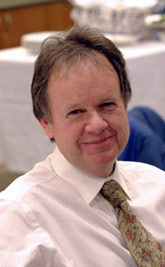
Handy Links
SLAC News Center
SLAC Today
- Subscribe
- Archives: Feb 2006-May 20, 2011
- Archives: May 23, 2011 and later
- Submit Feedback or Story Ideas
- About SLAC Today
SLAC News
Lab News
- Interactions
- Lightsources.org
- ILC NewsLine
- Int'l Science Grid This Week
- Fermilab Today
- Berkeley Lab News
- @brookhaven TODAY
- DOE Pulse
- CERN Courier
- DESY inForm
- US / LHC
SLAC Links
- Emergency
- Safety
- Policy Repository
- Site Entry Form

- Site Maps
- M & O Review
- Computing Status & Calendar
- SLAC Colloquium
- SLACspeak
- SLACspace
- SLAC Logo
- Café Menu
- Flea Market
- Web E-mail
- Marguerite Shuttle
- Discount Commuter Passes
-
Award Reporting Form
- SPIRES
- SciDoc
- Activity Groups
- Library
Stanford
Around the Bay
From the Director of Photon Science: Transitions

In today's director's column, I would like to inform you that I have decided to step down as associate laboratory director for the Photon Science Directorate at SLAC.
The directorate has been successfully reorganized over the past six months into two divisions: Chemical Sciences and Materials Sciences Divisions. We have initiated the SUN-CAT center, and the joint SLAC-Stanford institutes PULSE and SIMES are integrated into the divisional structure. The stage is now set for scientific growth in strategically selected research areas, aligned with SLAC and Department of Energy Basic Energy Sciences mission needs. Much of the research couples to and helps drive the experimental capabilities of the Linac Coherent Light Source and Stanford Synchrotron Radiation Lightsource. There are also new initiatives in areas that are not directly coupled to the lightsources. Plans are underway to add a third division (biosciences) in the coming year. We have developed a long-range space plan to augment the existing and soon-to-be renovated laboratory and office space in Building 40, to provide the needed infrastructure to achieve our vision for future growth. I am very pleased to have played a leadership role in helping create the Photon Science Directorate three years ago and positioning it to contribute strongly to SLAC's transition to a true multi-program laboratory.
My own roles and responsibilities at SLAC are however much broader than just ALD for Photon Science. I am SLAC's chief research officer, engaged in research policy and planning both within the laboratory and coordinating with DOE. I have the role of associate dean, shared with David MacFarlane for SLAC Faculty Affairs, broadly supporting faculty planning and appointment processes. Together with Britt Hedman, I steward the SSRL Structural Molecular Biology Program and Joint Center for Structural Genomics initiatives funded by National Institutes of Health and DOE-BER.
Over the summer, it has become clear that increased effort and focus is needed on my CRO, associate dean and SMB roles at the same time that the ALD role is assuming a more demanding time commitment and focus to achieve the goals set out for the directorate in the SLAC Agenda. Hence the decision to step down, allowing SLAC to make a new full-time appointment as the ALD for Photon Science and for me to re-focus and better direct my efforts strategically. SLAC Director Persis Drell has appointed a search committee to seek candidates for the ALD position. The committee is chaired by SSRL ALD Chi-Chang Kao. I will remain as ALD for Photon Science until a new leader is recruited and in place.
There are important opportunities for me to strengthen and support SLAC's science mission, working in close partnership with the SLAC Executive Council and the SLAC faculty and scientific staff. As CRO, there are functions such as more effectively interfacing with the national laboratory CRO organization to reform and strengthen DOE's research and operations policies, better aligning SLAC's planning processes (like the annual lab plan, the SLAC Agenda and the PEMP science and technology goals), and working closely with SLAC legal and procurement staff to evolve a robust work-for-others policy and comprehensive framework for intellectual property issues and technology transfer. In the role of associate dean, there are areas of increased planning and coordination with the Stanford Schools of Earth Sciences, Engineering, Humanities and Sciences and Medicine for an anticipated increased number of joint faculty hires and issues such as principal investigator privileges and postdoctoral scholar policies. The SMB program has recently undergone a very comprehensive and successful five-year peer review by DOE and NIH, but emerging areas of strategic focus like LCLS-coupled experiments and expanded SSRL programs are important for our future.
I will miss working day-to-day with the very talented and dedicated faculty, scientific, administrative and technical staff who have really built the Photon Science Directorate into what it is today. In the future, I look forward to working with them, along with colleagues in the other mission and mission-support directorates to help realize SLAC's bold vision of being the world-leading photon science laboratory by 2020. Thank you all for your help and support in the past and into the future.
